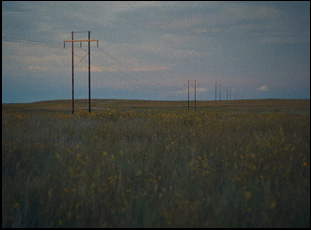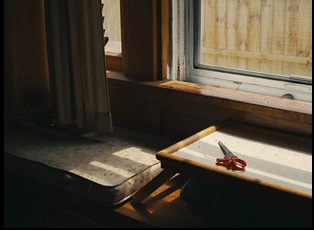During one of their serendipitous stops in filming what would become “The Last Days of August,” Rodrigo Ojeda-Beck and Robert Machoian were standing in front of some empty storefronts in the small town of Kendall, Nebraska when they were approached by a police officer who asked what the two were up to, unsure of what might be worth committing to celluloid when there was no one else around.
“The way he framed it as he approached us was he said, ‘Are you guys filming ghosts?’” recalled Ojeda-Beck, who was startled for reasons you might not think. “And I was like ‘Wow, what a beautiful image – to film the unseeable and how that would register on a camera,’ so then that was in [Robert and I’s] conversations. When we started filming, we were like, “What would that experience actually be like to film a ghost and and how do you evoke that emotion?”
While people were few and far between in the communities that Ojeda-Beck and Machoian traveled to for “The Last Days of August,” they found plenty of soul to summon in the bewitching 13-minute short making its west coast debut at Palm Springs Shortfest this weekend and its New York premiere at BAMcinemafest next week. Speaking to those who have stayed behind in rural areas after mom and pop shops on main street have been decimated by e-commerce and farmers traditionally take the hit, the co-directors are privy to doomsday ruminations after it appears as if the apocalypse has already happened with dilapidated schools and empty movie theaters once full of people now sit idle. Yet that talk is contradicted with their mere presence in front of the camera, carrying on even as they might be led to believe the world is crumbling around them, perhaps at a crossroads but moving nonetheless and inspiring Machoian and Ojeda-Beck to try to split the difference between still photography and movies where each individual frame in their short becomes its own rapturous experience.
On the eve of “The Last Days of August”’s bicoastal bows, the filmmakers behind some of our favorite films in recent years such as “God Bless the Child” and “When She Runs” spoke about reuniting for the project, capturing elusive spirits and delivering a stark rebuke against any claims that cinema is dead.

Robert Machoian: I lived there almost right out of high school for a period of time and it very much felt like a second home because I went from a farming community to another farming community with really very different objectives. In California, we were growing tomatoes and broccoli and in Nebraska, we were growing mainly corn, but also soybeans and cattle, which was all very new. But I’ve always had a great love for that area and it was a big shift for me coming from California where often when you meet somebody you ask what they do, which is their job and when I would ask that question out in Nebraska, it was not the job. It was like “I hunt” or “I four-wheel” — the actual things that they defined themselves by, so as Rodrigo and I were talking about projects to do together, I just really wanted for him to experience the community out there and said, “Hey, do we go out and travel around Nebraska?”
Rodrigo Ojeda-Beck: Yeah, we were also looking for areas that had a lot of small towns and a small radius. We didn’t know all the details of what we wanted to document at the start of the project, but we knew that documenting the decline of small towns was one aspect we were really interested in. When Robert was showing me around, we were traveling by van essentially, so it was really nice to travel five, ten miles and we’d have a different town just to check out the people and the landscape and to have different conversations and see where that’d guide us to the next place.
How much scouting do you do before starting to shoot?
Robert Machoian: One of the things that was important for Rodrigo and I was to think about photo books and we looked at the photo book aesthetics – artists that we knew had traveled to these regions and how they approached that. Some of it was following the same intuition I think photographers follow, which is really what about where we currently are is motivating us to feel like we need to make an image here. In our collaboration over years, we don’t have a destination and when you’re driving sometimes you get real focused on a destination. It’s great to have a partner who’s like I feel we should stop right here and you don’t have the insecurities of [asking] what if there’s nothing here to make an image with? We just pull over and if there’s an image that gets created, then there is and if not, we just hop back in the car.
Rodrigo Ojeda-Beck: Yeah, that was a really great way to work at least on this project because all of a sudden chance encounters start to guide the hand in that we’d talk to one subject and he would mention another town and that he didn’t want his town to end up like that town, so we’d be like, “Oh, we should go to that place.” Working that way allowed us to go into these communities without necessarily having a predetermined plan, so you lose that blinding that happens when you’re like, “This is the right idea for the film and it needs to be this.” Not having that plan allows you to be more open in terms of being guided by the people you’re filming and the landscape you’re documenting.
There’s a real self-reflexive quality once you bring in the movie theater that you show as empty – and yet there’s the following interview with the woman who says “A Walk to Remember” means so much to her. Was that obvious to bring into this?
Rodrigo Ojeda-Beck: Yeah, one aspect of this project that I loved was it was essentially a road trip with Robert and I. We live in different states now, so that time was really special to just be on the road together and every five years in the film community discourse, someone declares that cinema is dead, so when we were shooting this film, that discourse had come around and we were talking a lot about what is the role of film in society. That was just a conversation in the background between Robert and I and again, when you don’t have everything prescribed, these things seep into the movie.
Film is a pretty great space for miracles to happen and there’s something very magical about cinema, so as we interviewed people, we asked every person what their favorite movie was and we were always moved by how profound their answers were. On the surface, maybe “A Walk to Remember” isn’t the most profound choice. Other people went with Tarkovsky, which to me might match the profundity of the question to some degree, but once you hear the rationale [for “A Walk to Remember”], it makes complete sense – this [woman’s] reflection on both how lucky she is to have her daughter be alive and remembering her father who’s passed away, so film becomes this vehicle of meditation in a lot of ways for the individuals we talked to in their own ways. As we were hearing these responses, we were thinking, “These are amazing” and wanted to start filming movie theaters, so it just came together that way.
Is this the first time you’ve done on-camera interviews before?
Robert Machoian: Yeah, I think it was exciting for both of us, and the first interview we did, I’m next to the camera just trying to contain how excited I was. Part of that was because Rod and I are both fans of photo books and in the early discussions, [we spoke about how] these portraits are so beautiful, but you don’t get to hear the people and sometimes you’re thinking they’re looking really stoic as a result of the photographer, not the person themselves. It’s obviously not new to documentary, but this photo book approach was like, “Could we let subjects to speak?” and we did not have an objective in the speaking, so as they started to share things, that’s where I was like, “Oh my God, I’m looking at this photographic frame and we’re hearing these very profound things that people are able to say.” And Rod is really good at sitting there and not asking more questions, so [people we interview] start to get very nervous and continue to talk. The result of that is they diverge a lot from the initial question and it starts to be things that are inside of them, like the guy in the restaurant when he’s talking about his views about the end of the world. That just came out of this why are you guys not asking me questions? [laughs] And of course, I’m sitting there freaked out and Rod is just calmly like, “Something profound will come.” So outside of what is your favorite movie and maybe one or two other questions, it was really trying to discover who the people were.
Rodrigo Ojeda-Beck: Yeah, one of our references for the film is early Errol Morris films – “Gates of Heaven” and particularly “Vernon, Florida” — and I just find these people say very profound things, so our main objective during the interviews was let’s just get them to say something interesting. When you give that space, it always happens. People are just so interesting and they were so giving and kind and just a joy to work with, just sit down for two or three hours, depending on how the conversation went. And the point in an interview where you create that space [when] I’m like, “Now you dictate to me what you actually want to talk about or what is actually on your mind,” really it’s a pretty powerful act to listen and it just felt rewarding [to hear] them speak on it. Robert composed [the subjects] so beautifully, and this is the kind of thing that I think photographers can sometimes struggle with, which is both getting the beautiful visual image of people and also allowing themselves to create that frame and choosing a little more how to represent themselves, so it was a fun way to work.

Rodrigo Ojeda-Beck: Yeah, a lot of the time, I would pull over and Robert would find a great frame — something that we maybe would want to film — and I’d just start recording sound, so I had a lot of field recordings. It was really interesting to juxtapose sound with image and the frames are so open, it was really a creative process because it wasn’t so much we had to be beholden to in representing the reality in the frame. One thing we were trying to do was make sure that the images were still framed photographically, but still felt cinematic so it could hold a viewer’s attention, so we were constantly trying to find these micro changes in the frame or micro movements that sound could flesh out.
In a lot of the still frames, sound all of a sudden becomes so powerful. Film is an audiovisual medium, so [you’re thinking] how [sound] activates the frame, and trying to think beyond the frame, I had a list of field recordings and a lot of material to work with, but one thing Robert and I talk about is not getting stuck in what is. Film is so good at representing reality that sometimes artistically it’s hard to push past that and be like, don’t get stuck in what is, but try and think about what can be. All of a sudden adding these footsteps really activate this frame in an ethereal ghostlike manner, so it was fun to push the sound a little further and [ask] how can we get to a more uncanny vibe.
Robert Machoian: Yeah, one of the things I really loved as it relates to the sound design was how it was very quiet where we were most of the time. The train plays this major role in that area because it’s one of the loudest sounds. Otherwise, we’re in areas that I was consistently as we traveled was surprised about how quiet the world was. As Rod really worked on the sound design, I felt very representational to how much silence there was and how important these sounds were because of the lack of sound.
Robert, when you return to these places, had it changed much? I know in small towns like this, it can feel like they’re frozen in time after most of the population has left.
Robert Machoian: Yeah, one of the interesting things about that area specifically is this inherent optimism that things will change because there is this history of change. It didn’t make it into the film, but Jim, who is one of the first people we interviewed, talked about the three oil booms that had occurred in Kimball and they had this bumper sticker, that I’m paraphrasing, like, “Please God, let us have one more boom and we won’t spoil it this time.” So there’s this inherent optimism. And when we were filming in this gym [at an abandoned school], it’s a beautiful gym and an old man came up to us and we were like, “What occurred here? Why is it so desolate?” And he’s like, “There were no more children.” And you don’t imagine there’s a world where there’s no more children, but here we were staring at a building that no longer functioned as a result of the town no longer having children. So you watch that ebb and flow and it’s an interesting tipping back and forth that occurred [because] when we left, we heard there’s some missile silos outside of Kimball that are being refurbished, so they were getting what could be another boom.
Rodrigo Ojeda-Beck: Yeah, it was important for us, dealing with these tragic circumstances, [to properly convey] the people we interviewed — they’re all very prideful and hopeful, so that’s some of the rationale editorially why we started moving some of the stuff that we shot of Robert’s kids into the film. We originally shot that as test footage…
Robert Machoian: Yeah, it was not initially intended. Rod and I were having these conversations about that and I didn’t anticipate it making its way into the film, but then the second Rod laid the edit down, it felt like that age disparity was very critical. It was like we were dealing with these polar opposites of time as it relates to this optimism that children have and then this pessimism that not all older people have, but that the end is coming in many ways, so those polar opposites felt very important.
Rodrigo Ojeda-Beck: It was about how do we visually establish a sense of hope that isn’t just having a subject say that or being too literal about it. That seemed to be against the general feel of the film to have someone come out and say this small anecdote of like, “Go out and be hopeful. Don’t give up.” It just didn’t feel correct, so by extending that age range, it helped established some of that more nuanced ending, tilting towards hope, at least in our eyes.
It was so beautiful. What’s it been like to hit the road with a final film?
Robert Machoian: We were able to attend Big Sky and True/False, which are both great and I was so thankful for both those experiences and did not know personally how necessary they were for myself. Just being back with people in a dark theater spoke to how important community is. But then to be able to have an audience experience it and to know that some of the things that Rodrigo and I had discussed…we always try and lean into subtlety and [you run the] risk of having people miss it, but the things that they most often didn’t miss was really exciting.
Rodrigo Ojeda-Beck: Yeah, it was pretty cathartic [after] this idea of filming in an empty theater and being like is this what the future is going to hold and then to be in an audience, watching your own film and people telling you what they thought about your film or how they reacted to it. It felt like this culture will survive in some way, shape or form, so getting that reaffirmation especially after the pandemic and being able to come back to a theater space, like Robert’s saying, I didn’t know how much I actually needed that until I got it again. That was so magical and we always say that we make these films and we screen them for people and then they tell us what they mean. What we’re trying to say for ourselves is always ambiguous and we’re trying to work through it and when we show it to an audience, they’re like, “This is what you were trying to say,” so to experience that live after so many years of just being online was really nice.
“The Last Days of August” will screen at the Palm Springs Shortsfest on June 24th at the Camelot Theaters at 10 am and on June 29th at BAMcinemafest in New York with “Happer’s Comet” at the BAM Rose Cinemas at 7 pm.




